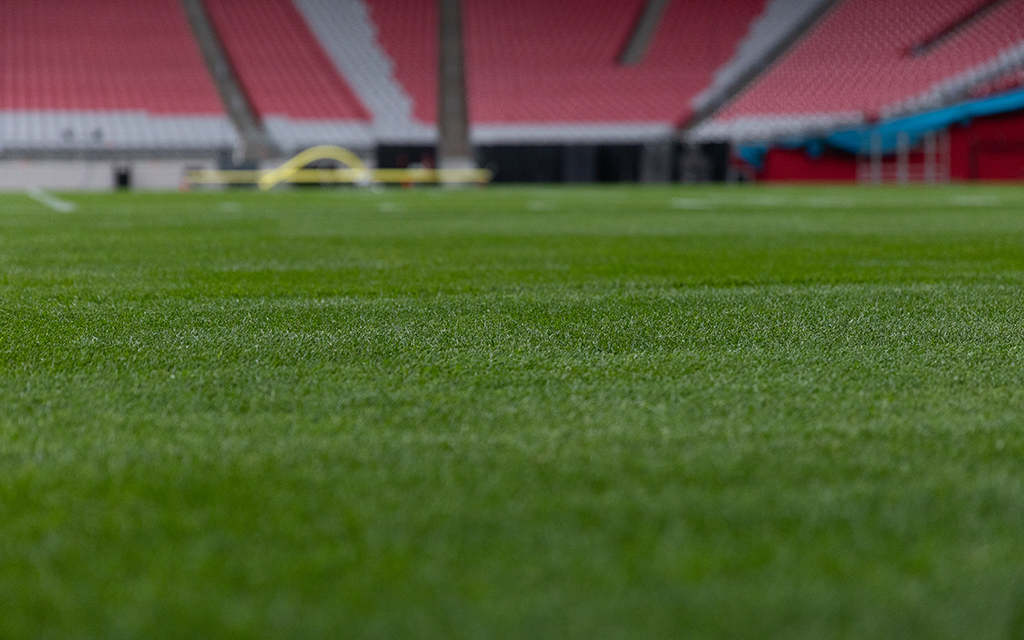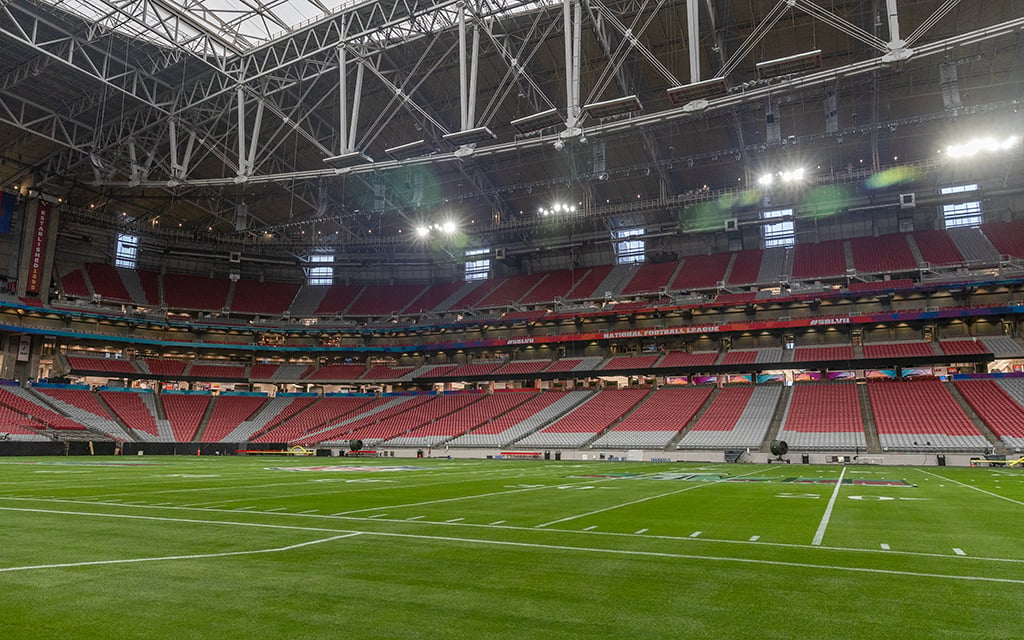
The State Farm Stadium field for Super Bowl 57 caused slick conditions for the Kansas City Chiefs and Philadelphia Eagles and forced players to change their cleats mid-game. (Photo by Susan Wong/Cronkite News)
GLENDALE – George Toma knows what went wrong with the field at Super Bowl 57, or so he thinks.
Among the standout performances of Patrick Mahomes, Jalen Hurts and Rihanna, the playing surface at State Farm Stadium stole the show on Super Bowl Sunday as the Philadelphia Eagles and Kansas City Chiefs players slipped as if Mesa’s Golfland Sunsplash water park hosted the game.
Fans took to social media to criticize the field conditions for the biggest game of the year, viewed by 113.1 million, and players continued the conversation in postgame media availability sessions. Eagles offensive lineman Jordan Mailata described the field as “playing on a water park.”
Toma, “The Sodfather,” took it a step further Monday in an interview with ESPN by pointing blame at the NFL and league field director Ed Mangan, who oversaw the field for last month’s Super Bowl.
“So what (Mangan) does, he waters the hell out of it and puts it right into the stadium, and that’s it,” Toma said. “Never sees sunlight again. He can’t do that.”
Toma, 94, has worked on all 57 Super Bowl fields, mostly in the role of head groundskeeper. He announced Super Bowl 57 as his last one with plans to retire, ending an eight-decade run in the business. Working in a reduced role in recent years, he was Mangan’s consultant in his final year.
The grass field was watered on Wednesday morning before the game, according to Toma, and quickly rolled into the stadium on a movable tray four days before kickoff.
Unique engineering that makes football in the desert comfortable for players and fans will be on full display at #SuperBowl 57 in Glendale, Arizona.
With its rollout natural grass field and retractable roof, State Farm Stadium was the first of its kind when it opened in 2006 pic.twitter.com/bfkE29JJeP
— USA TODAY Sports (@usatodaysports) February 9, 2023
He says the field should have been kept outside to dry first. Instead, only a tarp protected the field during pregame, halftime and postgame rehearsals, creating a “rotten smell.” Toma said he was notified the week of the big game that the field began to rot.
The oversaturated field only contributed to players’ footing issues due to the nature of the Tahoma 31 grass. The grass is a hybrid Bermuda grass consisting of a mix between ryegrass and Bermuda grass. Big chunks of it were stuck to cleats and forced players to change footwear mid-game.
The NFL has spent two years preparing the grass for tonight's field at the Super Bowl.
The grass was grown at a local sod farm in Phoenix.
It was installed two weeks ago, and the field has been rolled out each morning for daily sunshine.
Total cost = $800,000 pic.twitter.com/Um8zZala2O
— Joe Pompliano (@JoePompliano) February 12, 2023
Dr. Yanqi Wu, a plant and soil sciences professor at Oklahoma State University, created the grass mix in 2006 – and it’s now used all over the country, including at the Eagles’ home stadium at Lincoln Financial Field.
“The hybrid uses Bermuda grass at the base that is overseeded with ryegrass,” Wu said. “When you see the green color grass that, that is the ryegrass and at the base is Bermuda grass – a grass that is basically dormant in Arizona.”
Bermuda grass is a warm-season grass that grows best in a warm and humid environment, hence why it struggles to grow in Arizona. Ryegrass is a cool season grass that thrives at 50 F-65 F. The average temperature in Glendale from Feb.1 to Feb.12 fluctuated between 46°F-70°F, almost ideal weather.
Ryegrass provides a vibrant green that’s pleasing to the viewer’s eyes, but it can come at a cost.
“When the ryegrass leaf surface becomes wet or has moisture on it, the surface becomes very slick like a waxy surface,” Wu said.
That helps explain postgame comments from Eagles linebacker Hasson Reddick, who voiced his frustration following the 38-35 loss.
“I’m not going to lie, it was the worst field that I’ve ever played on,” Reddick said. “It was very disappointing, it’s the NFL. You would think it would be better so we could get some better play, but it is what it is.
“It didn’t even matter. I changed my cleats, still had studs and was still slipping so I don’t know. I don’t want to use it as an excuse. I’m not that type of guy. I’m not going to make any excuses.”
Toma, on the other hand, had no issues finding fault based on his experience using ryegrass in 27 Super Bowls.
“He (Mangan) sanded it two weeks too late,” Toma said. “He had only one sanding. He should have had two or three sandings, but he didn’t do s—-. And that was it.
“And not only that, he didn’t take care of it. He wouldn’t listen to anybody.”
Richard White, a soil and crop sciences professor at Texas A&M, supported Toma’s point after learning the field was installed in State Farm Stadium two weeks before Super Bowl Sunday.
“In some cases, they will use what we call pre-terminated ryegrass to plant it and speed up the process of seedling development to make sure the field has an ascetically pleasing color,” White said. “In other cases, it does not take a lot of topdressing, in my opinion, to get the pre-terminated ryegrass to have enough soil contact to develop quickly enough for an NFL game.”
“Two weeks is insufficient for seeding ryegrass in an NFL venue to have the field tolerate that kind of traffic and stress that an NFL game puts on,” White continued. “In my experience in other venues, it takes about six weeks for the ryegrass to become mature enough to provide benefits in NFL games.”
White’s background includes working with the Major League Soccer and NFL teams to rebuild stadium fields.
State Farm Stadium and NRG Stadium, home of the Houston Texans, are two of 10 NFL stadiums to have a dome roof. The overwatered grass during a cool desert night in the mid-60s with the roof open could have made the issue worse.
“In an indoor stadium like State Farm Stadium, early in late afternoon games, dew formations can occur,” said White, who worked with the Texans as an agronomic advisor for 11 seasons. “Putting moisture on a slippery cuticle like ryegrass, that’s where the real issue with slipping came from.
“If you have the roof open, that is a big contributor because you allow more radiational cooling to occur. A cooler desert climate is going to cause dew formation as plants build up turgor pressure inside their cells causing the omission of Capetian fluid out the tip of the leaf. It is another contributing factor that can occur and would likely have been a contributor in that particular environment at that event.”
The extra moisture on top of an overwatered field explains the struggle for players on both Super Bowl teams to grip the playing surface – evident by the countless number of players falling to the grass, including Eagles kicker Jake Elliot on a kickoff and Chiefs running back Isaiah Pacheco on a touchdown celebration.
This field is bad. Jake Elliott slips on the kickoff. pic.twitter.com/6Xhf54oteR
— Arye Pulli (@AryePulli) February 13, 2023
⭕ TOUCHDOWN CHIEFS! ⭕
Isiah Pacheco powers through. One score game… ?#SuperBowl | Sky Sports ? pic.twitter.com/7S9lFT9q8z
— Sky Sports NFL (@SkySportsNFL) February 13, 2023
Despite the inadequate playing surface, Eagles coach Nick Sirianni did not blame the loss solely on the field.
“It’s not like we were playing on ice and they were playing on grass,” Sirianni said. “We all had to play on it, we all have to figure out our shoes.”
The NFL released a statement the day after Super Bowl 57 that said “the State Farm Stadium field surface met the required standards for the maintenance of natural surfaces, as per NFL policy. The natural grass surface was tested throughout Super Bowl week and was in compliance with all mandatory NFL practices.”
Toma doesn’t buy it, and says the league is on its own for Super Bowl 58 in Las Vegas.
“I can’t take it anymore,” Toma said. “Me and the league are finished. They can’t tell me what to do anymore.
“We’re done.”


